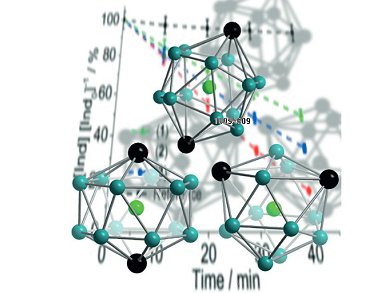Solid-state lanthanide vanadium oxides are technologically important materials with applications in catalysis, photocatalysis, electrode materials, radionuclide separation, and luminescent materials. In contrast, little is known about their molecular counterparts. In particular, no cerium-functionalized vanadate clusters had been reported until recently [1], despite the well-known photocatalytic, photoluminescence, and magnetic properties of solid-state cerium vanadates.
Andrey Seliverstov and Carsten Streb, Ulm University, Germany, report two new di-cerium-containing vanadium oxide clusters [(Ce(dmso)4)2V11O30Cl]⋅DMSO and [(Ce(nmp)4)2V12O32Cl]⋅NMP⋅Me2CO (NMP = N-methyl-2-pyrrolidone). A fragmentation and reaggregation approach was used in which vanadium oxide precursors are fragmented in organic solvents forming reactive fragments [VOx(solv)y]n−. These fragments were subsequently reassembled into heterometallic clusters in the presence of linking metal ions and anionic templates. The clusters are all based on square-pyramidal [VO5] building blocks arranged around central chloride templates and this synthetic approach allows the precise tuning of the cluster architecture including the position and orientation of the cerium centers.
The compounds show promising visible-light photooxidative activity for the oxidative degradation of a prototype pollutant (indigo) with quantum efficiencies >10 %.
- A New Class of Homogeneous Visible-Light Photocatalysts: Molecular Cerium Vanadium Oxide Clusters
Andrey Seliverstov, Carsten Streb
Chem. Europ. J. 2014.
DOI: 10.1002/chem.201402337
1] Chirality meets visible-light photocatalysis in a molecular cerium vanadium oxide cluster, A. Seliverstov, C. Streb, Chem. Commun. 2014, 50, 1827. DOI: 10.1039/C3CC48834A



